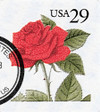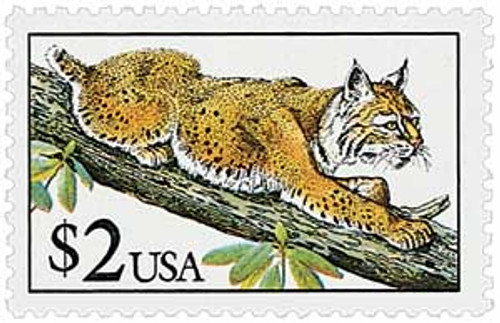
# 2490 - 1993-95 29c Red Rose
US #2490
1993 Rose
- Part of Flora and Fauna series
- Second self-adhesive definitive issued in 1993
- Second self-adhesive produced by Stamp Venturers
- Produced in booklets of 18 and coils
Stamp Category: Definitive
Set: Flora and Fauna Series
Value: 29¢, First Class mail rate
First Day of Issue: August 19, 1993
First Day City: Houston, Texas
Quantity Issued: 900,000,000
Printed by: Stamp Venturers
Printing Method: Photogravure
Format: Panes of 18 from cylinders of 360 and coils from cylinders of 220
Perforations: Die Cut
Why the stamp was issued: This stamp was issued to cover the First-Class mail rate. It was one of the first self-adhesive definitives of 1993 issued to satisfy customer demand. Roses have been the subject of many previous US postage stamps.
About the stamp design: The image for the Rose stamp was originally intended for a Love stamp. In 1987, 79-year-old artist, Gyo Fujikawa was asked by the USPS to submit sketches of roses for a future Love stamp. She made seven sketches suing gouache (opaque watercolor). Four years later, Fujikawa was asked to make a finished painting of one of the sketches she had submitted. Unfortunately, by that time her eyesight had deteriorated, and she wasn’t able to produce the painting. Officials with the USPS then decided her original sketch could be used, and the Rose stamp was the result.
About the printing process: The stamp was produced as a pane of 18 that could be folded into a booklet. Collectors could also buy coil strips of 18.
First Day City: The First Day of Issue ceremony took place during Stampshow 99, held in Houston, Texas. This exhibition was held as part of the annual meeting of the American Philatelic Society.
Unusual fact about this stamp: This stamp was sold before its official issue date. The earliest known use was July 16. In addition, a cover with a July 26 postmark was sent to Linn’s Stamp News. This was 24 days before the First Day of Issue ceremony.
About the Flora and Fauna series:
The Flora and Fauna stamps picture plants and animals found in the United States. The definitives were originally called the “Wildlife” series, which replaced the Great Americans series. The first stamp in the series was the $2 Bobcat issued in June 1990. The first time the term “Flora and Fauna” was used for the series was nine years later, when the Red-Headed Woodpecker stamp was used.
The series contained 36 face-different stamps. The flora stamps pictured flowers, berries, fruit, and a pinecone. The fauna stamps mostly depicted birds but also included four-footed animals, a honeybee, and a sunfish. The final stamps in the series were issued in 2001.
History the stamp represents:
What’s in a name? that which we call a rose,
By any other name would smell as sweet.
–Shakespeare
Say the word “rose,” and it conjures up images of one of the most beautiful of all flowers. With its delicate, sweet-smelling blossom, this lovely flower has long been a symbol of beauty.
First cultivated in Asia, the rose has become popular in many countries throughout the world. In fact, it is the national flower of the United States, and several states including Georgia, Iowa, and North Dakota have chosen the rose as their state flower.
One of the largest and most important families of flowering plants, the rose family contains over 3,400 species of trees, shrubs, and herbs - including plants that produce fruit, such as pears, peaches, plums, and cherries.
In addition to being used for decoration, the rose provides us with several useful products. Fine woods from its various trees are used in cabinetmaking and woodworking. Attar, an oil obtained from the rose petal is used to make perfumes. And the edible, berrylike “fruit” of the rose, called hips, is used in making teas, jellies and other preserves.
US #2490
1993 Rose
- Part of Flora and Fauna series
- Second self-adhesive definitive issued in 1993
- Second self-adhesive produced by Stamp Venturers
- Produced in booklets of 18 and coils
Stamp Category: Definitive
Set: Flora and Fauna Series
Value: 29¢, First Class mail rate
First Day of Issue: August 19, 1993
First Day City: Houston, Texas
Quantity Issued: 900,000,000
Printed by: Stamp Venturers
Printing Method: Photogravure
Format: Panes of 18 from cylinders of 360 and coils from cylinders of 220
Perforations: Die Cut
Why the stamp was issued: This stamp was issued to cover the First-Class mail rate. It was one of the first self-adhesive definitives of 1993 issued to satisfy customer demand. Roses have been the subject of many previous US postage stamps.
About the stamp design: The image for the Rose stamp was originally intended for a Love stamp. In 1987, 79-year-old artist, Gyo Fujikawa was asked by the USPS to submit sketches of roses for a future Love stamp. She made seven sketches suing gouache (opaque watercolor). Four years later, Fujikawa was asked to make a finished painting of one of the sketches she had submitted. Unfortunately, by that time her eyesight had deteriorated, and she wasn’t able to produce the painting. Officials with the USPS then decided her original sketch could be used, and the Rose stamp was the result.
About the printing process: The stamp was produced as a pane of 18 that could be folded into a booklet. Collectors could also buy coil strips of 18.
First Day City: The First Day of Issue ceremony took place during Stampshow 99, held in Houston, Texas. This exhibition was held as part of the annual meeting of the American Philatelic Society.
Unusual fact about this stamp: This stamp was sold before its official issue date. The earliest known use was July 16. In addition, a cover with a July 26 postmark was sent to Linn’s Stamp News. This was 24 days before the First Day of Issue ceremony.
About the Flora and Fauna series:
The Flora and Fauna stamps picture plants and animals found in the United States. The definitives were originally called the “Wildlife” series, which replaced the Great Americans series. The first stamp in the series was the $2 Bobcat issued in June 1990. The first time the term “Flora and Fauna” was used for the series was nine years later, when the Red-Headed Woodpecker stamp was used.
The series contained 36 face-different stamps. The flora stamps pictured flowers, berries, fruit, and a pinecone. The fauna stamps mostly depicted birds but also included four-footed animals, a honeybee, and a sunfish. The final stamps in the series were issued in 2001.
History the stamp represents:
What’s in a name? that which we call a rose,
By any other name would smell as sweet.
–Shakespeare
Say the word “rose,” and it conjures up images of one of the most beautiful of all flowers. With its delicate, sweet-smelling blossom, this lovely flower has long been a symbol of beauty.
First cultivated in Asia, the rose has become popular in many countries throughout the world. In fact, it is the national flower of the United States, and several states including Georgia, Iowa, and North Dakota have chosen the rose as their state flower.
One of the largest and most important families of flowering plants, the rose family contains over 3,400 species of trees, shrubs, and herbs - including plants that produce fruit, such as pears, peaches, plums, and cherries.
In addition to being used for decoration, the rose provides us with several useful products. Fine woods from its various trees are used in cabinetmaking and woodworking. Attar, an oil obtained from the rose petal is used to make perfumes. And the edible, berrylike “fruit” of the rose, called hips, is used in making teas, jellies and other preserves.




















